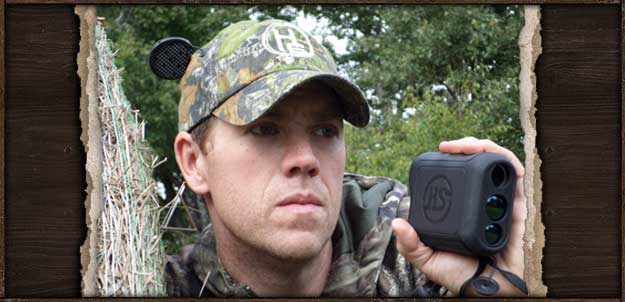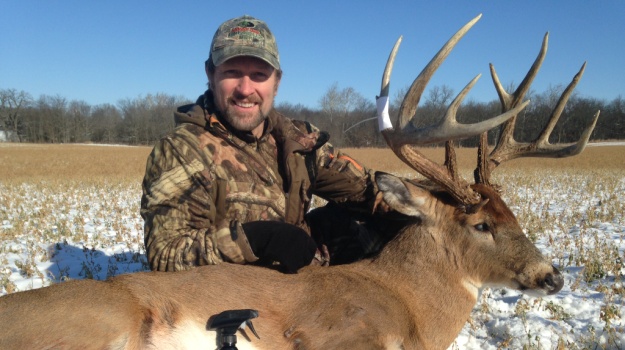by Heath Wood | Mossy Oak ProStaff

As a modern day bowhunter, I find myself with an abundance of the latest and greatest gear to make my hunts more successful. New calls, scents and other gear that is supposed to make that big buck magically appear...if only it were that easy.
Sometimes, I have to take a step back and see what gear is really a must have. All gear has its place and yes, it all does work depending on the time of year and what you're doing. That being said, there are a few items that are a must have for every hunt. One of those "must have items" for me is a good rangefinder. Over the last few years, the technology behind rangefinders has skyrocketed. The quality, ease of use and effectiveness is mind blowing. I have compiled a few tips and tricks of how to get the most out of your rangefinder all season long.
This summer, I began practicing with my bow around the 1st of July. After a good check up of all my equipment at my local archery pro shop, I began with the basics of shooting. The basics meaning that I check and see if all my sights are on target and hitting the same mark on a consistent basis. This is also when I began taking advantage of my rangefinder.
This year is the first year I began using my new Hunter's Specialties Legacy Series rangefinder made by Bresser Optics. This new rangefinder is one of the easiest rangefinders I have ever used. All the user has to do is turn it on, click on the target, and the yardage is displayed. Yes, it is that simple and efficient.
I begin by placing my target at the edge of my yard that is a good open area free of limbs, tall grass or anything else that might deflect my shot. I then use my rangefinder and mark exactly 10, 20, 30 and 40-yard markers. I shoot at each spot until each sight is set and my arrows are all hitting the bullseye consistently. After my sights are set, I range different yardages such as 12, 15, 25, 28, etc., shooting enough to get familiar with my sights at different markers then just what the sights are set up for. This lets me know what my bow will do at every shot that I take. The last step is to set multiple targets out, then walk all over shooting at random yardages and random angles all before I range. I guess the yardage in my head, shoot, and then range. This prepares me so that if I don't have my rangefinder while hunting, I still have a good idea because of thorough practice.
The next use for my rangefinder is after I get my tree stands in place. After I get strapped in my safety harness, the first thing I do is range different shot scenarios that might take place. I range from my stand to trails, stand to a scrape, anywhere a buck may be. Then I pick out different landmarks such as a certain tree, rock or stump so that I know if a deer walks by one of the ranged marks, I will know how far he is without having to make unnecessary movement. Although I keep my rangefinder with me at all times, sometimes the action happens quick and I might not have time to range him. By marking a few spots ahead of time, I'm not just guessing how far he is.
The last place I use my rangefinder is while I'm hunting, like I mentioned earlier. I always have my rangefinder within reach while hunting. I usually have mine hanging on a hook next to my grunt call and rattling bag. As my hunt progresses, I will range random markers just to refresh my mind of different distances. I will also range does that walk through, squirrels, raccoons, whatever just to give me a better sense of all shot scenarios.
During the pre rut, and rut stages I use a lot of scent. I usually put my liquid scent on a wick that hangs from a limb. I always put that wick at exactly 20 yards, because that is my best shot. Whatever your best shot is, that is where I suggest you put your scent. I do the same thing with my doe estrus scent wafers from Hunter's Specialties. They come 3 in a package, so I will place them at 3 different yardages so that I can use them as an attractant as well as a yardage markers.
Another place a rangefinder comes in to play well is if you are spot and stalking an animal. You can use it to see how far the animal is. Plus, you can see how far you have to move by using a rangefinder. For example, If you have a buck at 150 yards out in a field and you are bowhunting, you know from practice that your range is within 50 yards. Which means you know you have 100 yards to move.
I have always said I feel like a more successful hunter when I am the most prepared that I can be. By using a good rangefinder I feel like I am more prepared as a shooter. I am more comfortable by taking a shot because I know what my equipment will do, and I am a better hunter because I know what my bow will do when that trophy buck makes his way into my hunting location.






























